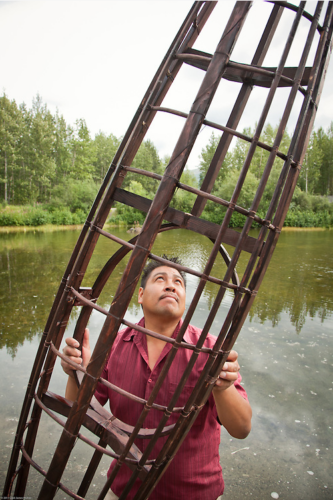
Born in Anchorage, Alaska and raised in the Bristol Bay village of Pilot Point, Andrew Abyo (uh-BY-oh) is a Sugpiaq carver who seeks to learn and pass on his cultural traditions. He wants his three children and others to have a greater understanding of the Sugpiaq culture and its rich history. “My goal is to bring out different things that you normally don’t get to see, other than in a museum.”
Now based in Anchorage, Andrew is known for his in-depth historical research, which helps him to add authentic details to each of his works. He specializes in making Sugpiaq kayaks (full-size & model), bentwood visors, atlatls, harpoons, paddles, and traditional games. Andrew’s work has been recognized as museum quality, and examples of his carvings can be found in collections around the world.
Each year, Andrew hosts cultural presentations in schools and at culture camps, and teaches classes and workshops at the university level; he also spreads his knowledge by demonstrating his craft at the Alaska Native Heritage Center in Anchorage. Sharing Sugpiaq culture through teaching others is a large part of his mission as an artist.
(Image credit: Clark James Mishler)
Interview with Andrew Abyo
(conducted by James Miller, 12/4/21)
The following is a transcript of the UAF student interview with Andrew Abyo, conducted by James Miller as part of a group project, which took place via Zoom on December 4, 2021.
Andrew Abyo: Hello, can you hear me?
James: Yes, I can. It’s nice to finally meet you.
Andrew Abyo: Oh, yes, good to meet you. Sorry, I’m not too tech-savvy. I got this set up on my cell phone. [laughs]
James: Yeah, no, you’re perfectly fine. I definitely understand that as well. So, I know I emailed you—I’m part of a group of students taking a class at UAF, and we identified you—there’s about eight of us—as the Native artist that we wanted to interview. As far as I know, because it’s sort of the end of the semester, we’re all super busy, so I’m sort of the only one that can make this meeting.
Andrew Abyo: Okay.
James: All right, so just starting off with the first question: some places online refer to you as “Alutiiq,” but others as “Sugpiaq;” in another interview you used “Sugpiaq” yourself—by your definition, is Sugpiaq more correct, and is there a difference between Sugpiaq and Alutiiq?” And I apologize if I did not pronounce those correctly. [laughs]
Andrew Abyo: Oh, no, you pronounced them correctly. So, the word “Alutiiq” is actually a word that was given by the Russians when they were here in the 18th century.
James: Oh, wow.

Andrew Abyo: 1700s. And so, it’s like the word “Aleut” is the Russian given name. The name “the true people” is the “Unangan.” And those are the people of the actual Aleutian Islands and the Pribilof islands.
James: Wow, that’s—I had no clue about that, thank you, that’s very interesting.
Andrew Abyo: Oh, sure. And so, the “Sugpiaq” people, that is the same thing as the “Unangan.” The “Sugpiaq”—that is their true name of the tribe.
James: Gotcha.
Andrew Abyo: Yes. And so, I think I read in one book that “Aleut” was like a generalized term to distinguish, like, “you’re Unangan,” and “you’re Sugpiaq”—they were just like, “you guys are all Aleut.” [laughs]
James: Yeah. [laughs]
Andrew Abyo: Yes. And I think I read in one book that the term “Alutiiq” came along as a designator that you were a mix of Russian and…we’ll say Aleut. Yes.
James: Gotcha. Well, thank you, that’s very interesting. I had no idea about that. Go ahead and move on to the next question.
Andrew Abyo: Yeah. One thing I want to [add is that] the Sugpiaq people are from Kodiak, the Alaska Peninsula, and also Prince William Sound.
James: Gotcha.
Andrew Abyo: Yes.
James: So, you’ve said in other interviews that you began to discover your culture through research when you began creating art—was there anything that sticks out in your memory that you were surprised to discover through this research?
Andrew Abyo: Oh, yeah, my first art piece that I made—of any kind, of any nature—I made an atlatl at the Alaska Native Heritage Center, and that was in 2005, and I just discovered it was natural inside of me and I had no idea. And so, I always wanted to make artwork, so after I started that first piece, then I wanted to continue making more, and then research on my own.

Image credit: Anchorage Daily News
I would go to the cultural books and see the artifacts in the books, and I was at first looking at photos and trying to better my artwork. And then, alongside there, is all the history of my people. From there, it just interested me to learn more. And so, yeah, that’s what spurred my interest, was initially to do the artwork, and then, alongside there, I started reading about my history and my culture and I was like, “Wow, we are…we have a lot to be proud of.”
James: Yeah.
Andrew Abyo: Yes.
James: That’s, I mean, from our class—we’re taking the History of Native Arts class—so we’re getting a lot of that. I mean, me, I’ve been born and raised in Fairbanks, and of course, I do not belong to any Native tribe or anything. So, I honestly didn’t have a lot of knowledge about them, and through this class I’ve learned a lot, and it is extremely interesting.
Andrew Abyo: Yes. And to see the ingenuity that they came up with in some of the artifacts, that, like, one tool can do multiple things, not just…. Like, take for instance, the bentwood visor—that one shields your eyes from the sun, the glare of the water in the kayak, and it actually has over eleven different uses. And, through my research, I was able to find out a lot of different uses.
James: Yeah. Moving on to the next question: do you feel like becoming a traditional artist and delving into your ancestral history/who you are, has defined or redefined you, or have you felt more of a connection to your heritage as a result?
Andrew Abyo: Yes, it has definitely given me a more…connection to my heritage or my culture traditions. I remember, I myself did not know anything about, you know, the history and the culture of the Sugpiaq people or the Unangan. And so, I, at the time, had my two daughters, and I was thinking, “Well, if they don’t know their own culture and history, then I have to learn to teach them,” so. That is one of the other main reasons why I started, is so I can pass this—learn this—and pass it on to my kids.
James: That’s awesome. That’s really cool. Yeah, no, I mean, very interesting to me—like, of course I’m looking at all of this different stuff from an outside view, and it’s just a beautiful thing. And then seeing that, with your case, you said you want to pass it down to your children—I think that’s just an awesome thing.
Andrew Abyo: Yes, thank you. Like, what I do today, I never imagined that I would be doing this—traveling and teaching, doing presentations on the history, becoming an ambassador of the culture. I tell people, if you knew me in 2004 and you knew what I was going to be doing, in the, like, after 2005, all these…teaching, and doing these presentations, and making all this art.
Now I have artwork all over the world—all over Alaska, and done so many projects. I would have never imagined that, at all. [laughs]
James: Yeah. [laughs]
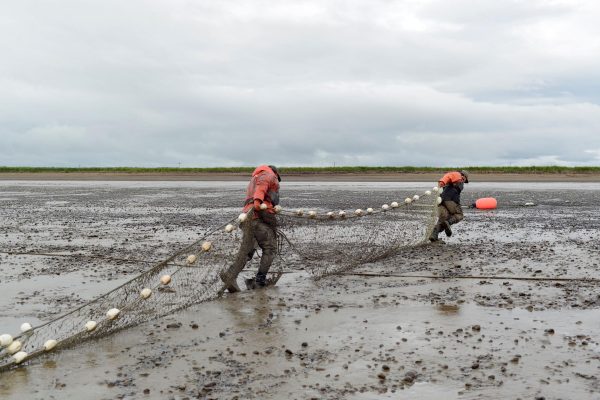
Image credit: Mitch Borden, KDLG
Andrew Abyo: It is, yeah, it’s just one year—I mean, 2004 and 2005—it’s just totally removed from each other. Before that, I was just working at a 9-to-5 job, and I grew up commercial fishing in Bristol Bay, and I was Alaska Native—and that’s all I knew. [laughs] So yeah, then in 2005, and as the years progressed, I started to learn more about my…yeah, the history, and so….
James: Yeah, so, on the topic of, you know, you working a 9-to-5 job, our next question is actually centered around that: how did the environment you grew up in, in your upbringing, influence your decision to eventually switch from a typical 9-to-5 job and become an artist? How has that upbringing influenced or contributed to your work?
Andrew Abyo: I, let’s see, I’m not too sure how to answer that. I just…it was a passion for me to learn more about my culture. And, in the process, I started—I remember my first teaching, where I had some students, and that was at the Alaska Native Heritage Center, and so it all grew from there.
I remember my first class, and [laughs], I remember being quite nervous about that, and then—now, I am very comfortable traveling and teaching different areas. I’ve worked at the Anchorage School District, UAA, APU, traveled to outlying villages and taught classes out there—workshops—like bentwood visors, bird rattles, so many things—paddles, I’ve taught, and…so, yeah.
James: Yeah, so staying on the topic, as far as you mentioned you had a 9-to-5 job: what was the hardest part about transitioning from your secure 9-to-5 job to being a full-time artist and teacher?
Andrew Abyo: Oh yes, I remember that day, that was… [laughs]. Me and my wife…so, I had a job at Alaska Mill and Feed, and then I had $500, and me and my wife, we went to Sears, and I bought $500 worth of tools, and that was the transition right there. It’s like, okay, stepping out of this secure 9-to-5 job, and then, now I’m self-employed. Yeah. [laughs] That was very scary. [laughs]

Image credit: ANHC
James: [laughs] Yeah, no I bet. But, I think it, pretty clearly, it’s worked out really well. As far as, what you’re doing now and stuff, it’s really impressive.
Andrew Abyo: Yes, thank you. It is very rewarding for me to teach others, as well as my kids. It’s just something that came natural to me—teaching, and having a lot of patience for students. And I enjoy it.
James: Moving on from that question, so: through your work, have you ever experienced any kind of artist’s block, or gotten stumped on any sort of project? And if so, how did you get past it, or what did you do to kind of regain your motivation or inspiration?
Andrew Abyo: Yeah, and actually—artist’s block, I’ve only experienced that twice so far, really. In 2017, we were living in a real sweet apartment on Minnesota [Dr.] and Spenard [Rd.]. That’s right next to the Center Bowl—if you know where that is—bowling alley.
James: I think I’m familiar with the location, yeah.
Andrew Abyo: Okay, so, the building that we were in—it was actually February, the morning of February 15—the apartment caught on fire. And, so, it was very traumatic; we barely escaped with the fire at our door. And, there were others that did not escape that night. Three had perished that night, and then there was a fourth one that was badly burned, and they had to bring her to Seattle. She had over 80% burns, and…but she didn’t survive, so, it took four people altogether.
And, yeah, it displaced the whole building. I can’t remember how many families. And that was the point where I couldn’t work for a while. I just had a block, I didn’t know why. Just the trauma, I think. And, it took a while to finally get to working again. It’s like therapy for me, to work.
And then recently, with the COVID [pandemic], that also affected me. There were so many stressful times, and because I’m self-employed…I had like ten contracts lined up—that’ll keep me through the winter and through the summer, working—and [laughs] then all in the course of one week, when COVID hit, all those contracts just got canceled. And that was pretty scary, that was traumatic. [laughs]

And it took a while for me to get back into working. And now I’m at a point where I’m just coming out of it and working again. Because I remember, I’d be like, I need to do some of these projects, and I can’t even lift up a carving knife or a paint brush to work on them. And I was like, “Why?” I’m asking myself, “Why is it like this?” [laughs]
So yeah, it is different. That’s one thing about 9-to-5 and self-employed is, if you have the 9-to-5 job, you go and do your job—9-to-5, clock-in, clock-out—but the self-employed is so different. Yeah, so that was a challenge.
James: So, the biggest thing you think, that helped you get through, you know, those artist’s blocks, was essentially just time?
Andrew Abyo: Yes.
James: Gotcha.
Andrew Abyo: Yeah, and then finally getting back into the work really helped me to start working again.
James: Yeah. Moving on to the next question we have: how has teaching and instructing others had an impact on you and/or your practice?
Andrew Abyo: Oh, teaching others…. I do enjoy teaching others. For one, they get to learn new things and, for me, it’s a way for me to pass on the knowledge that I learned, and it’s a way to keep the traditions alive in the culture. And, not only that, it helps bring it back. So that’s my view—is to share what I learn.
And for me to teach, and when I see someone trying to learn and struggle, and then they finally—you can see that spark in their eye—and they’re like, “Oh, I got it now!” And then they see—like, if I’m teaching a bentwood visor, or any kind of art piece—they finish, and it’s painted beautifully and finished. And I say, “Wow, you did an amazing job!” And then they say, “Well, you’re a good teacher.” And, so, that’s what helps. That’s rewarding.
James: Yeah. So, on the topic, like, when you teach classes on bentwood visors and such, so—teaching others how to make traditional pieces—do you also pass on the historical uses and the meanings behind those pieces?
Andrew Abyo: Yes, I do. As we are working on the projects, I will go through and make sure that they learn what each piece can do, how they made them, and how they’re used—and also games. I was down in Cordova this past September, teaching them how to play a traditional dart game. And yeah, that is very rewarding for them to enjoy what they’ve done—they’ve made hand darts and hand targets, and they’re able to shoot those targets with what they made. [laughs]
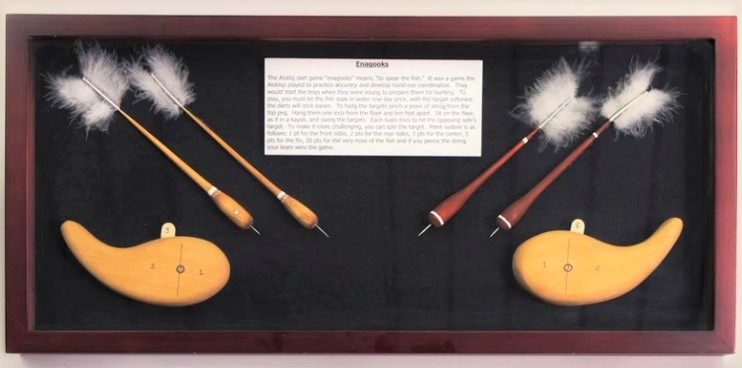
I remember one time, on the same subject, when I was doing presentations in November for Native Heritage Month here in the Anchorage School District. And this same game—it was recurring—I was in, like, my second or third year, and I had the same presentation for the different students every year. I had that dart game, it was a training game they taught at five years old, and so they had to sit with their feet forward, like they’re in a kayak. And the target is swinging in front of them, like ten feet away, from a string, and it’s one inch off the ground. And they had to hit that swinging target, and that was all in training for use of the atlatl.
But then one student in particular, he remembered me—it was at Susitna Elementary School, I remember that. And he said, “Oh, do you have that game?” He’s all excited. And he said, “I love that game. I don’t even play my Xbox anymore.” [laughs] Yeah, that was pretty awesome to hear. [laughs]
James: [laughs] Yeah. So related to that, when it comes to your teaching, what is the most important thing you want people to know or take away from your classes?
Andrew Abyo: A greater understanding of the Native culture, and the ingenuity that they had with what they created. Because I not only teach Native students at Culture Camps, but also others, like APU or UAA, and non-native—just for them to have a greater understanding of the people. So, like if I do the Native Culture Camps, it’s for me to help them learn of their ancestors. So, it’s two different things. If you understand.
James: Yeah, I’m following. So, teaching during the pandemic, I’m sure, came with a lot of challenges. What were the ways that you had to alter your teaching methods, and/or changed up the projects you’ve taught to be able to continue to pass on your art to others?
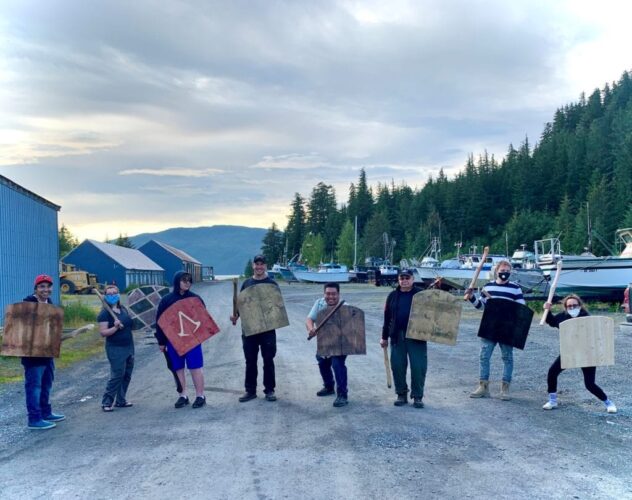
Image credit: Teal Hansen, Cordova Times
Andrew Abyo: Ah, yes. I have since, twice now, gone to Cordova during the pandemic. And we all use the same mandates: washing of hands, social distancing, wearing masks, and limited group size. So that’s been successful. I’ve gone down there twice now since the pandemic, and I teach a kayak Indigenous class model projects at Alaska Pacific University every January. I think this might be my fourth year doing it.
So, last year we put together a Zoom class. So I had to—instead of the students, you know, having the wood material in front of them, and then they would put the patterns onto, like, the bow, and the stern, and the deck beams—they had to cut those out in class. But since we had students that social distanced, actually, they built them at their homes. So I had to cut every piece, and then we put them in a kit form, and mailed them out to wherever they were.
And so that was a challenge, because that’s a lot of cutting for me, putting in several hours just to get the kits together. But it was nice. We were able to expand the class. So I had a student in, I think it was Wisconsin. I had one in Florida. I had one in Wasilla. One in Kodiak. And there was one student that—he was able to come to the class, and he was able to attend the class there, and build the model kayak, which was 41 inches long. It’s a 1/6-scale kayak. So, yeah, we were able to expand it with the use of Zoom class.
James: Yeah, Zoom has certainly been helpful during the pandemic. [laughs]
Andrew Abyo: Yes, it has. There was another Culture Camp that—it was one of those contracts that had gotten canceled when it first started, the pandemic. It was in the Pacific Northwest with an Alutiiq group down there. I had a Zoom class with them to build a kayak—and this was before it was more relaxed, because we still didn’t know much about it [COVID-19], so I just wanted to make something that was really easy.

Image credit: PNW Alutiiq Culture Camp
So I made all the parts of the pattern on paper, and they were able to download it from their computer and cut out the pieces. And then we just made it very simple. We used Scotch tape, and they had all the necessary parts—the bow, the stern, the ribs—to make a kayak. Yeah, that was our first endeavor into Zoom class after the pandemic started.
James: So, when it comes to your artwork, a lot of it’s praised for its authenticity and faithfulness to tradition. Was it difficult to track down information about certain art forms? Specifically, some cultural masks, which are burned after performances, you know, throughout history? And related to that, how do you approach these art forms that there aren’t a lot of examples of?
Andrew Abyo: Initially, yes, I relied on the books to do the research. And then, like, for the masks, there was another mask maker named Perry Eaton, from Kodiak. And I met him—I knew of his work, I’d seen his masks—and then I met him at the Alaska Native Heritage Center, and I asked him if I could apprentice with him. And so, he said, “Well, I’m semi-retired now, and I think I have time.” And he said, “Why don’t you come out to my house on Sunday?” So, I started learning from him, how to make the Sugpiaq masks.
James: Wow.
Andrew Abyo: And, yeah, he was a great teacher—helped me learn a lot about the history of the masks.
James: That’s very awesome.
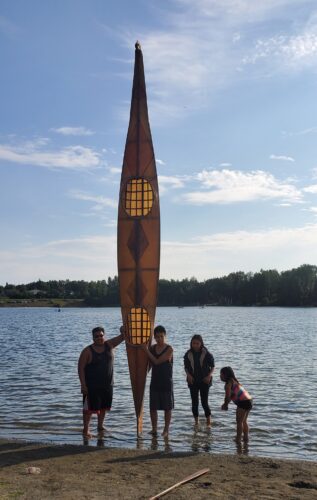
Andrew Abyo: Yes. So aside from doing research in the books, I also asked my elders, and others that are familiar. Like the kayak building—I, let’s see, I started my first kayak in 2008, and that was at Culture Camp. I was just assisting them, for a full-size kayak. And then 2009 came around, and I was all excited—“Hey, I can’t wait to help build you guys another kayak!” And then they’re like, “Andrew, how about you make your own kayak?” That was at—it’s called Urban Unangax Culture Camp—and that’s at Aleutian Pribilof Islands Association. And so, yeah, that was my first learning of building the kayak. So, like I said, I go to others who can help me learn also.
James: Yeah. So, still staying on the topic of your artwork, when designing your artwork, do you usually adhere more or less strictly to existing historical pieces, or do you like to kind of experiment and individualize certain things? Or maybe it’s a mix of both?
Andrew Abyo: Yeah, when I first started, I was staying in, kind of, the boundaries—for lack of a better word—of what the art was like, such as masks and kayaks. So now, I think it was two years ago now, there was this mask I had an idea, for a while, where I took a round mask that was one of our traditional masks in the Sugpiaq culture, it was round. And then I carved that out in the same manner that it’s supposed to be, but I mixed it with kayak pieces.
So I have this round mask, and then I surrounded it with, like, the hatch of a kayak, and then I built the kayak pieces around it—so, the hatch and the stanchions and part of the ribs and the keel. So yeah, it was a mix of two things—disciplines, I would say. And yeah, it turned out great; it turned into a very contemporary art piece. So that was received very well, and I do intend to make more of those—I want to make that one become a signature piece from me, because nobody else has done that mask before in that style.
James: Is there anywhere online—like, the way you’re describing it, it sounds incredibly beautiful—is there anywhere, like, I could go, or maybe someone else in my group could go, view a piece of that online?
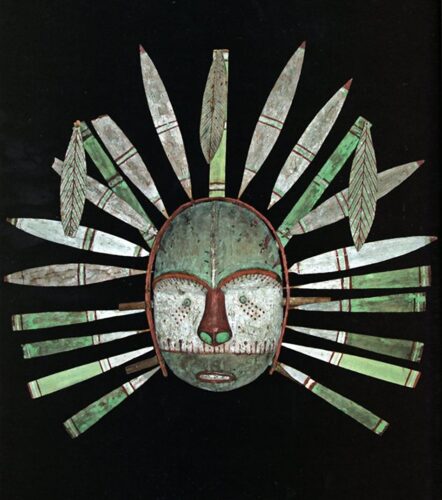
Image taken from: Eix del Mon
Andrew Abyo: I currently don’t have a website; I need to build a new one. So I think this next coming year—yeah, I need to build a new website. So I do have a lot of my photos on Facebook. Right now, that’s it. And if you send me your email—you could text it to me—and I could get some higher-resolution photos off my email of the ones I’ve taken, because it’s the same photo, and Facebook has a lower resolution. I have the original photos in my email.
James: All right, I’m definitely going to check them out. I’m sure if someone else in my group has the same question, I’ll probably forward you their emails, if they want to get their hands on a higher-resolution photo.
Andrew Abyo: Oh sure, and actually on my Facebook—if you’re able to access that—there’s albums on my Facebook that has, I think it says “Andrew’s Artwork,” and I have a lot of photos of my past examples of work on there.
James: Alright, I’m definitely planning on checking that out. I’ll probably do it after this interview.
Andrew Abyo: Sure, sure.
James: Moving on, from that question: so, out of all the things that you make, throughout your time as an artist, do you have a favorite one to make more often, and if so, why?
Andrew Abyo: My latest one is the 1/6 kayak scale model, it’s 41 inches long, and, yeah, when they are finished—it doesn’t have the traditional covering on there—I used a 2 oz. Ceconite on there [a durable polyester fabric], to cover it. But then I would color it in the traditional style, and put all the hunting equipment on—tied onto the kayak—as well as the paddler itself, and he has a visor, a bentwood visor. And that’s pretty much my favorite one right now. When they are finished it’s quite an outstanding example.
James: Yeah, I mean, I’ve seen from online—when we were researching you and stuff—we’ve seen your artwork and the pieces you’ve made, like your smaller kayaks and stuff. They’ve been really beautiful. So when it comes to, you know, your favorite pieces of art, do you have, like, a specific, individual piece of art that you’ve created that is your favorite, and if so, why?
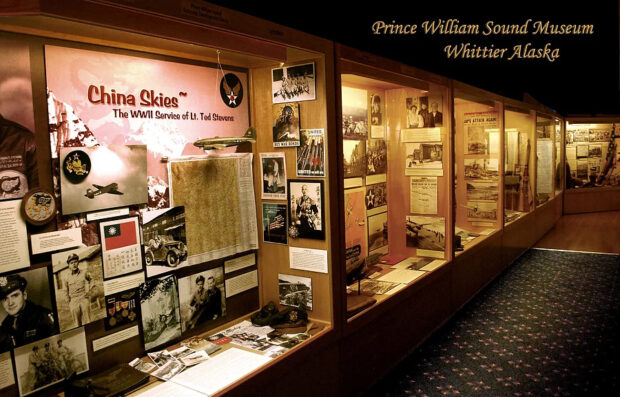
Andrew Abyo: Yes, actually, one of my latest pieces, I finished for the Whittier museum. I’m not sure if you’re familiar, but Whittier has a small museum over where their little store is, in a hotel, and not too many people know about it.
James: Yeah, I’ve been in the hotel in Whittier; I had no clue they had a little museum there, though.
Andrew Abyo: Yeah, actually there’s—you know that little store that’s down there? The one store? So when you walk in, and then the store is on your left, if you see the hallway on your right—and there’s a museum there. And it’s a small museum, but it’s like a little gem. It’s like, when you walk in there, it’s presented very well: there’s shadow boxes, there’s models, there’s all kinds of artifacts and in-depth history. And you’re thinking, “Wow, this is a little gem.” [laughs] I was very impressed when I walked in there—I was like, “Wow, I didn’t expect this!”
Ted Spencer is the one that hired me for a project for one of his display cases, and it was for an umiaq; he needed an umiaq in the timeframe of 1963 or so. So it’s still a traditional umiaq, but he had to put an outboard [motor] on there. And so, he had the outboard down in California, where he lives, and so he gave me the dimensions, and then I built the umiaq around his specifications.
And he wanted it to be authentic, and he wanted a rifle in there—a certain kind of rifle that the Native Guard, the [Alaska Territorial Guard (ATG), a WWII US Army military reserve force, active from 1942-1947]—that they used, the rifles. He wanted one of those in there, and it was so small it was like, almost a little bigger than the size of your index finger, right? That little, mini rifle, bolt-action—and I even got the little, tiny bolt-action to work. [laughs]
James: Oh, wow. [laughs]
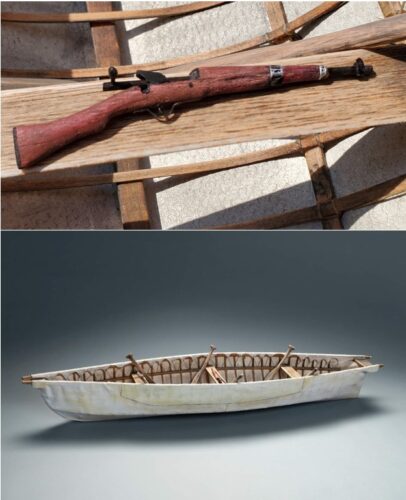
Andrew Abyo: Yeah—a little, tiny bolt, and you could pull and move it. And then it had an anchor in there with a rope, and I built that little kicker tank for it. And then, aside from that, it was just the utmost detail I’ve ever put in any of my work.
Yeah, I’ll have to send you photos of that one. I had professional photos taken of it. And yeah, it is an outstanding example.
James: Yeah, I’d love to see them. And I’ll be sure to share it with my classmates, as well.
Andrew Abyo: Oh, sure. And yeah, that was a referral I got from an art gallery. Ted Spencer, he was the one—he contacted the gallery here in Anchorage, the Georgia Blue Gallery on Arctic [Blvd.]. Ted Spencer was looking for an umiaq model, and he couldn’t find one. And he said—when I sent him my work photos—he said, “Andrew, I’ve been looking for you for years.” [laughs] And so, yeah, that was quite a compliment to receive, and, so, I’m very proud of that one.
James: So, when it comes to—moving on to, like, your work with bentwood visors—how long on average does it take for you to create one from start to finish?
Andrew Abyo: Oh, like if we’re in a class workshop session, and I have at least, maybe, ten students? We could carve it, and steam-bend it, and get it painted in fourteen days.
James: Wow. Is that kind of like, across-the-board? Or, as these students go through, you know, does their [level of] experience come into play when it comes to making these bentwood visors? Or is it essentially just—across-the-board—fourteen days, just due to the nature of the visor?
Andrew Abyo: Yeah, some of them finish, and some of them don’t. But yeah, I could get one steam-bent, carved in at least two days, myself. And to steam it, it just takes one day to steam, let it sit for 24 hours, and then maybe a week to two weeks to paint it. The style of painting I do is very detailed, so it actually takes me longer to paint the visor than it takes to carve and steam-bend.
James: Wow. I think it shows through the work that we’ve seen, and such. I mean, your paintings on—for example—your bentwood visors, are very beautiful.
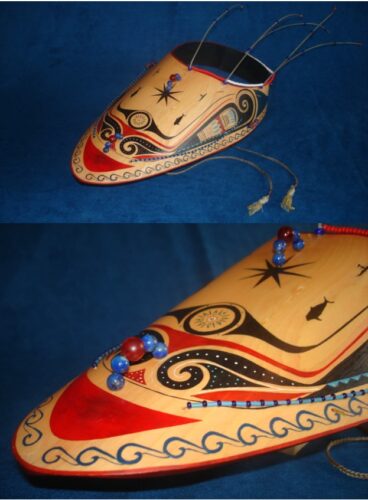
Image credit: Alutiiq Museum
Andrew Abyo: Yes, thank you. There was another lady that I met through other artists. She is from Europe, and she ordered two visors from me. So, that was amazing. [laughs]
James: So, when it comes to—like, just across your practice, including bentwood visors—do you only use motifs that you’ve found in historical and/or traditional artworks? Or do you also try to invent new motifs to use in your work?
Andrew Abyo: Yes, I like to stick to the traditional motifs, but also I bring out my own style, and try to incorporate it and stay within what I feel is appropriate—and to honor the ancestors.
James: Yeah. So, you’ve worked with so many different mediums—is there a medium or style that you have yet to try, but you hope to or plan to someday?
Andrew Abyo: That’s a good question. I mainly, of course, do wood carving, and so that came natural to me. I remember, it was amazing when I first started. Like, I would see—for example—like, a bird rattle in a book, and then after two weeks of carving it out and painting, and—I have this bird rattle in a book and then, maybe two weeks later, I have it in my hands. [laughs] That was always amazing. So, like I said, the wood carving came natural—working in 3-D form.
One thing that has been a challenge for me is doing 2-D work—two-dimensional—such as painting or drawing, and, like, landscape or figure, you know? And so, that’s the challenge for me; I mean, I don’t know why. [laughs] I still could do some drawing, where I’m real comfortable. And so, that’s a discipline that I want to learn also—is more formal training on painting. Because, I do know what I want to paint—sometimes I lose it in translation with the paintbrush.
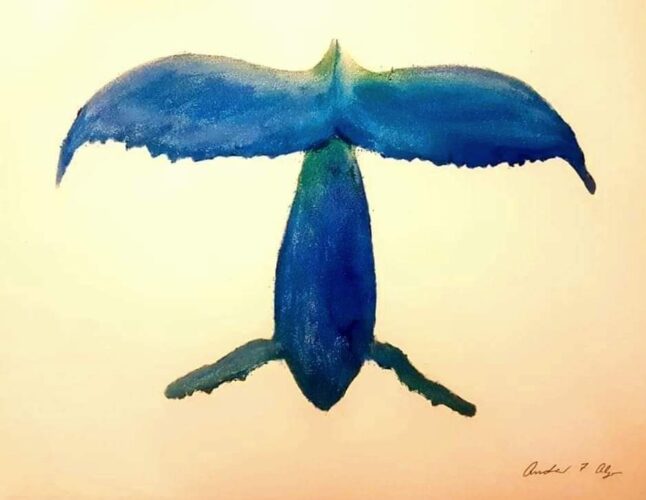
James: Yeah. [laughs] So, last question—I really appreciate your time, and I’m sure everyone else in my group does as well. You mentioned being part of the Alaska Native Heritage Center—what is it like being a part of such a vibrant community of artists, that work with you in the Alaska Native Heritage Center, or have worked with you in the past?
Andre Abyo: Oh yes, it’s great to be able to work with other artists and collaborate, or even just have—like, if I’m working on something, perhaps another artist might have ideas and help you along, and give you some advice or tips. So yeah, working at the Alaska Native Heritage Center has been very beneficial for me. I’ve taught many workshops there and got to work with many artists and learn from other artists.
James: So, when you have worked with other artists, is there something valuable that you’ve taken from a fellow creator? I know you mentioned doing the apprenticeship for your artwork, earlier on. But, what is something else that you’ve found of value when you’ve worked with someone else?
Andrew Abyo: Yes, actually, from my kayak teacher that I learned from—Mitch Poling. It was great to work with him. I started working with him, learning how to build a kayak in 2012, and built several kayaks with him. We helped them build two at the Alaska Native Heritage Center with another family that also has been learning to build kayaks, and then I was able to go to the Culture Camp called Nuuciq Spirit Camp, and that’s where Mitch Poling built kayaks also. He works with the people there, and that’s the Prince William Sound region.
But in particular, this one time, when I first started working with him, we were building the kayak, and we’re working on the stern, and he had a saw and we’re putting together the gunnels—and this is, like, one of the first steps to do the kayak—and he said, “I can’t tell you how to do this, you just have to watch.” [laughs]

So, yep, you can’t explain how to saw that, two pieces together, because—the gunnels are the outsides of the kayak, you know, that form the kayak at the bow and the stern, right? So you’re taking those two pieces, and you’re bringing them together, and then you take the saw, and then you saw right down the middle of where they join, right? And so we’re using the saw to bring those two pieces together, as one, if that makes sense.
James: Yeah, it does. [laughs]
Andrew Abyo: Yes, and so the same for the bow—so the bow and the stern. Yeah, there’s only a certain way you could saw, to do that. [laughs] That always stuck out, with what he said to me. He said, “I can’t teach you or I can’t tell you, you have to just watch.” [laughs] Yeah, and, unfortunately, he passed away in 2017, but I was able to work with him for several years.
In 2018, I built a kayak on my own. I had some help with some other kayak builders, but mainly it was just me finishing the kayak. And I was successful in finishing it. It is a huge contrast from my first kayak I taught, and that was at McLaughlin Youth Center, on my own. I had a lot of questions, and I still wasn’t confident, and I would call up my teacher, Mitch Poling, and I would ask him questions. And then, we got through it and we built it.
Then, in 2018, I built another kayak at the Alaska Native Heritage Center, and, yeah, it was like my graduating piece. I was completely confident in building the kayak: I knew what had to be done, I knew what parts needed to be made, and so, I was fully confident in that. And I think it’s thanks to Mitch Poling, who was my teacher.
James: So, with that being the last question, I’d just like to thank you for doing this with us. I’m sure you’re incredibly busy. Are there any closing remarks or anything you’d like to say?
Andrew Abyo: Oh, thank you for this opportunity. I look forward to being part of the artist community in your project there. So yeah, I enjoy teaching and continue to do more work. Other than that, I’m not sure what else to say about that.
James: Yeah, no you’re fine. Yep, we really—again, thank you so much for doing this. And yeah, thank you so much for giving us this opportunity.
Andrew Abyo: Oh yeah, you’re welcome. Thank you for your time, and yeah, I look forward to seeing your project put together.
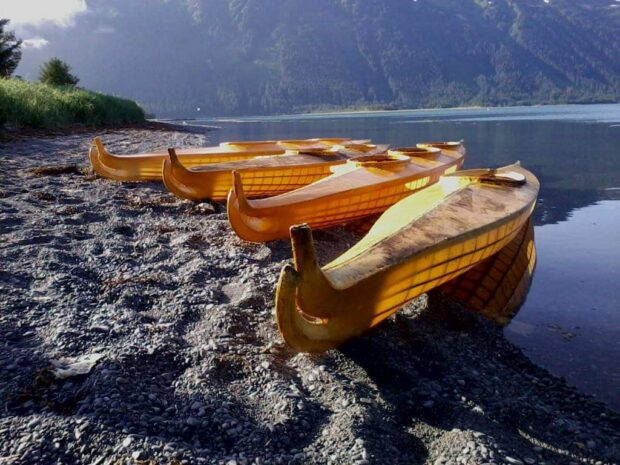
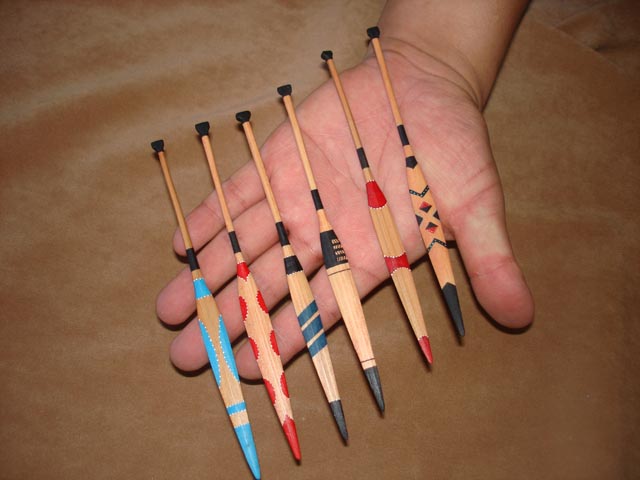
Image credit: Alutiiq Museum 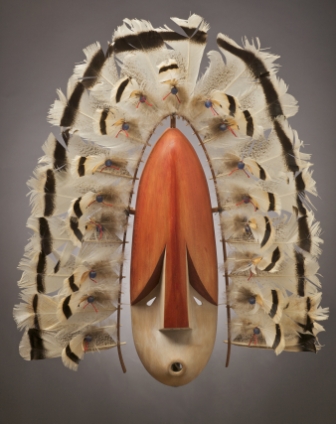
Image credit: Alutiiq Museum 
Image credit: Clark James Mishler
Additional Resources
Smithsonian Institution: Arctic Studies
Smithsonian Arctic Studies Center: Spotlight Presentation, 2011
Bibliography
- “Alaska Native Collections – Culture: Sugpiaq, Andrew Abyo.” Arctic Studies – Sharing Knowledge, Smithsonian Institution, 2013, https://alaska.si.edu/culture_sugpiaq.asp?bio=andrew_abyo.
- “Alaska Native Collections – Mask.” Arctic Studies – Sharing Knowledge, Smithsonian Institution, 6 Oct. 2011, https://alaska.si.edu/record.asp?id=711.
- AlaskaPublicMedia, KAKM Art Auction. “Kakm_2014, Sugpiaq or Alutiiq Paddle by Andrew Abyo, $1500.” Flickr, Yahoo!, 27 Jan. 2012, https://www.flickr.com/photos/alaskapublic/6768490871/.
- Alaska Refuge Friends. U.S. Department of the Interior Izembek National Wildlife Refuge Report, 26 Sept. 2017, https://alaskarefugefriends.org/wp-content/uploads/2017/10/FINAL-Izembek-Fall-2017-RAC-Report-RISDAHL.pdf.
- “Andrew Abyo – Medium: Carving.” Alutiiq Museum, https://alutiiqmuseum.org/shop/artist-bios/211-andrew-abyo.
- “Andrew Abyo.” Rasmuson Foundation, https://www.rasmuson.org/enjoy-cat/art-collection/andrew-abyo/.
- Baty, Elinor. “Building a Traditional Kayak through a Virtual Class.” Alaska News Source, 28 Jan. 2021, www.alaskasnewssource.com/2021/01/29/building-a-traditional-kayak-through-a-virtual-class/.
- “Block Course Teaches Kayak Design, Cultural Understanding.” Alaska Pacific University, 2 Feb. 2018, https://www.alaskapacific.edu/block-course-teaches-kayak-design-cultural-understanding/.
- Bragg, Beth. “It Came from the Ice Age, but the Atlatl Continues to Impress.” Anchorage Daily News, Anchorage Daily News, 1 May 2017, https://www.adn.com/outdoors-adventure/2017/04/30/it-came-from-the-ice-age-but-atlatl-continues-to-impress/.
- Brinck, Wolfgang. “Andrew’s Boat.” Andrew’s Boat, 1 Sept. 2010, http://skinboatjournal.blogspot.com/2010/09/andrews-boat.html.
- Eaton, Daysha. “Sugpiaq Artist Shares Work, Culture with Kodiak Residents.” KTOO, KMXT-Kodiak, 10 Aug. 2018, https://www.ktoo.org/2018/08/10/sugpiaq-artist-shares-work-culture-with-kodiak-residents/.
- Hansen, Teal. “Cultural Connections: Shield and War Club Class Preserves Native Culture.” The Cordova Times, 18 Sept. 2020, www.thecordovatimes.com/2020/09/18/commentary-shield-and-war-club-class-preserves-native-culture/.
- “Heritage Grant Successes.” Chugachmiut, 23 Jul. 2013, www.chugachmiut.org/2013/07/heritage-grant-successes/.
- Lancaster, Amanda. “Works by Five Artists Added to Alutiiq Museum Collection.” Alaska Native News, 27 Nov. 2019, https://alaska-native-news.com/works-by-five-artists-added-to-alutiiq-museum-collection/45969/.
- “Paper Kayak Workshop with Andrew Abyo.” Facebook, 26 Apr. 2020, https://facebook.com/events/d41d8cd9/paper-kayak-workshop-with-andrew-abyo/2618390531778000/.
- Renda, Lynette. “Teaching Alaska Native Culture through Art with Andrew Abyo-Motivate Me!-Day 31 Alaska.” YouTube, Motivate Me! TV, 13 Sept. 2017, https://www.youtube.com/watch?v=FN_84o3H3K4.
- Smithsonian Institution National Museum of Natural History. “Recovering Voices: Documenting & Sustaining Endangered Languages & Knowledge: From Kayaks to Masks: Traditions of Sugpiaq Carving [2011] on Apple Podcasts.” Apple Podcasts, 30 Dec. 2011, https://podcasts.apple.com/us/podcast/from-kayaks-to-masks-traditions-of-sugpiaq-carving-2011/id467414957?i=1000109712209.
